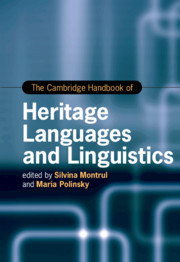Book contents
- The Cambridge Handbook of Heritage Languages and Linguistics
- Cambridge Handbooks In Language And Linguistics
- The Cambridge Handbook of Heritage Languages and Linguistics
- Copyright page
- Dedication
- Contents
- Figures and Tables
- Contributors
- Acknowledgments
- Introduction
- Part I Heritage Languages around the World
- 1 Slavic Heritage Languages around the Globe
- 2 Heritage Languages in Europe
- 3 Heritage Languages in Southeastern Europe
- 4 Heritage Languages in China
- 5 Heritage Languages in Japan and Korea
- 6 Heritage Languages in Israel
- 7 Heritage Languages in Aotearoa New Zealand and Australia
- 8 Heritage Languages in Canada
- 9 Asian Heritage Languages in the United States
- 10 The Vitality of Spanish as a Heritage Language in the United States
- 11 Germanic Heritage Varieties in the Americas
- 12 Arabic in North America
- 13 Heritage Languages in South America
- 14 Language Attrition and Heritage Language Reversal in Returnees
- Part II Research Approaches to Heritage Languages
- Part III Grammatical Aspects of Heritage Languages
- Part IV Heritage Language Education
- Index
- References
6 - Heritage Languages in Israel
A Multilingual Tapestry with Hebrew Threads
from Part I - Heritage Languages around the World
Published online by Cambridge University Press: 04 November 2021
- The Cambridge Handbook of Heritage Languages and Linguistics
- Cambridge Handbooks In Language And Linguistics
- The Cambridge Handbook of Heritage Languages and Linguistics
- Copyright page
- Dedication
- Contents
- Figures and Tables
- Contributors
- Acknowledgments
- Introduction
- Part I Heritage Languages around the World
- 1 Slavic Heritage Languages around the Globe
- 2 Heritage Languages in Europe
- 3 Heritage Languages in Southeastern Europe
- 4 Heritage Languages in China
- 5 Heritage Languages in Japan and Korea
- 6 Heritage Languages in Israel
- 7 Heritage Languages in Aotearoa New Zealand and Australia
- 8 Heritage Languages in Canada
- 9 Asian Heritage Languages in the United States
- 10 The Vitality of Spanish as a Heritage Language in the United States
- 11 Germanic Heritage Varieties in the Americas
- 12 Arabic in North America
- 13 Heritage Languages in South America
- 14 Language Attrition and Heritage Language Reversal in Returnees
- Part II Research Approaches to Heritage Languages
- Part III Grammatical Aspects of Heritage Languages
- Part IV Heritage Language Education
- Index
- References
Summary
Multilingualism in Israel emerged thousands of years ago with Hebrew, Judeo-Aramaic, and Greek all playing meaningful roles. Today`s multilingualism started to take shape with the return of Jews at the end of the nineteenth century and the revitalization of Hebrew. This reverse migration has given rise to a complex multilingual tapestry of 40–50 Heritage Languages (HLs) spoken by 1st, 2nd, 3rd generation immigrants, as well as indigenous vernaculars of Arabic. In the current chapter, we select five HLs (English, Russian, Amharic, Yiddish, and Juhuri), which vary considerably in the number of speakers, social status as perceived by in-group speakers and by the outside world, the presence and transmission of literacy, and by the aspiration of the speakers to integrate into Israeli society. Despite all these differences, all HLs interact with and are influenced to greater or lesser degrees by Hebrew, the only official language of the State of Israel, giving rise to hybrid versions identifiable with bilingual speakers of the particular language pair. The chapter overviews the linguistic and sociolinguistic properties of these HLs and discusses potential mechanisms that may account for divergence from native speakers in the country of origin or dominant speakers of the HL.
Keywords
- Type
- Chapter
- Information
- The Cambridge Handbook of Heritage Languages and Linguistics , pp. 129 - 155Publisher: Cambridge University PressPrint publication year: 2021
References
- 13
- Cited by

